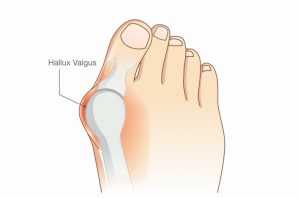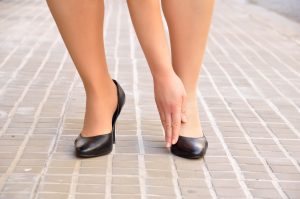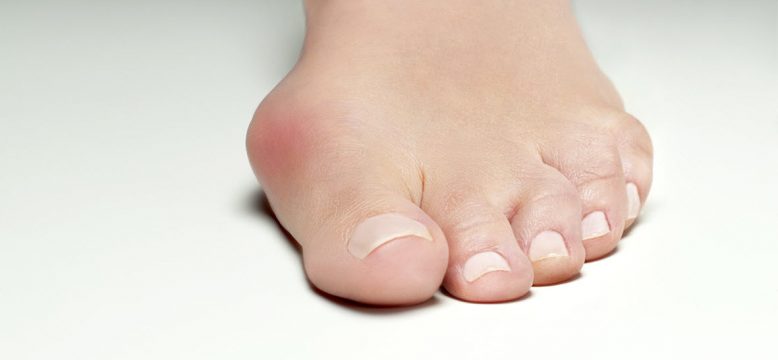How come my feet have developed bunions?
Bunions are common, really common! Current research suggests as many as 1 in 3 adults will develop a bunion. Bunions are more common in females (at least twice as common). The risk of bunion development increases as we get older. Too often people believe that the only treatment option for bunions is surgery. Many people are unaware that there are effective non-surgical treatments for bunions. However, seeking treatment early is the key to conservative treatment success.
So what are bunions?
 A bunion is a broad term that describes the deformity of the 1st Metatarsophalangeal Joint (MPJ) or the big toe. The technical name is Hallux Abducto Valgus (or Hallux Valgus). In simple terms this describes the deviation of the big toe towards the centre of the foot and the lesser digits.
A bunion is a broad term that describes the deformity of the 1st Metatarsophalangeal Joint (MPJ) or the big toe. The technical name is Hallux Abducto Valgus (or Hallux Valgus). In simple terms this describes the deviation of the big toe towards the centre of the foot and the lesser digits.
In many cases, bunions are a progressive and get worse over time. As the bunion progresses a bony growth or bump may develop at the big toe joint. This can make shoe fitting increasingly difficult and contribute to the development of pain. Bunions can also make people feel embarrassed of their feet because of the perception of ‘ugly or deformed feet’. Over time wear and tear to the misaligned joint can cause osteoarthritic change. This can make the bunion pain much worse.
So what causes bunions?
There are lots of factors that contribute to you getting a bunion. These include family genetics (hereditary factors), shoes, physical activities and most importantly foot alignment. Certain foot walking patterns can increase the likelihood of developing bunions.
For example a foot that excessively pronates (rolls in) can cause extra pressure on the big toe during walking. This extra stress on the big toe and can push it out of alignment overtime. Also, with each step the toes carry one half of your body weight – so this extra pressure can be significant. Given the thousands of daily steps the average person takes you can see how bunions can develop over time.
So let’s discuss some of the contributing bunion development factors in a bit more detail.
Family Genetics – Hereditary Factors
There is no doubt that there is a link between bunions and hereditary factors. Hereditary factors are biological characteristics that are passed down via genetics from our parents. These traits often relate to misalignment of joints of the feet and legs. This can affect the way the muscles pull on the big toes you stand or walks. This can contribute to bunions forming.
If you improve the alignment of the feet and legs and strengthen the relevant muscles around the big toe joint you can actively treat and improve the bunion. This is especially true when treatment is sort early. Have a look at your mum, dads and/or grandparents feet. If they have a bunion then your risk for developing a bunion is likely increased. So having your feet checked could go a long way to avoiding bunions.
Shoes
 Ladies – this is a common factor affecting your feet. So many of the shoes available for women are designed for fashion not necessarily function. The typical high heel is tapered at the front and has room for three toes not five. Also, the higher the heel the more pressure is placed directly onto your big toe. This pressure can accelerate a deviation of the big toe toward a bunion.
Ladies – this is a common factor affecting your feet. So many of the shoes available for women are designed for fashion not necessarily function. The typical high heel is tapered at the front and has room for three toes not five. Also, the higher the heel the more pressure is placed directly onto your big toe. This pressure can accelerate a deviation of the big toe toward a bunion.
So those killer heels might just end up killing your feet!
In addition shoes that are too tight (width or length) can also dramatically increase the risk of bunion development.
Shoes however are not the “be all end all” in bunion development. Bunions have been observed in the Maasai people of Kenya who have never worn shoes. You have probably also got ‘that friend’ who can seem to “get away with” wearing fashion footwear. The truth is they are probably just genetically lucky.
If you have the wrong genetic make-up and foot function then wearing the wrong shoes can dramatically increase your risk of bunion development. So choose your daily shoes wisely!
Physical activities – sport or exercise
 Sport and exercise in itself is definitely not a cause of bunions. In fact, being active is good for your overall health and wellbeing. The problem with increased activity levels occurs when you have poor strength and foot alignment. The extra stress and load this places on the big toe can increase bunion development over time.
Sport and exercise in itself is definitely not a cause of bunions. In fact, being active is good for your overall health and wellbeing. The problem with increased activity levels occurs when you have poor strength and foot alignment. The extra stress and load this places on the big toe can increase bunion development over time.
Also as we exercise we gradually begin to fatigue. This can lead to increasing poor foot function and big toe stress. The best thing to do in is to undertake a variety of activities. Varying the repetitive stress on the feet and big toe and can help to reduce the risk of bunion changes.
So as you can see there are a number of factors that determine why your feet develop bunions and why they get progressively worse over time. The key thing to remember is there are non-surgical treatment options that can really help put a spring back in your step.
The goal of conservative treatment is to stabilise and reduce the deviation in your big toes – the bunion. The most important thing is early assessment and intervention. This will maximise your chance of success. The longer the bunion has been there the more difficult it is to address and the longer therapy usually takes.
More blog posts…






Thanks for the food info, Mike